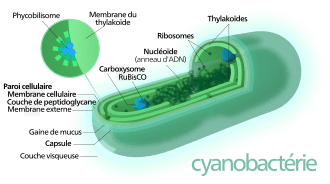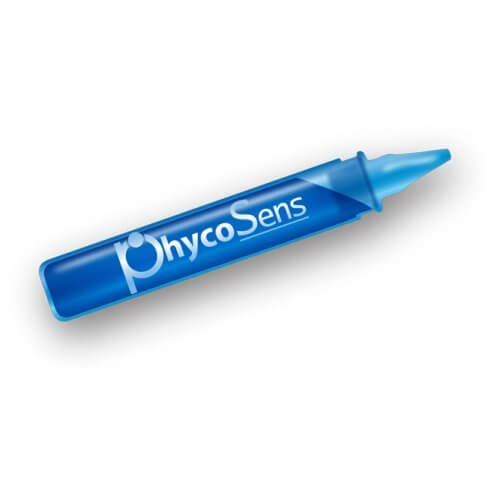Phycocyanine: 7000 times more active than Spirulina and 20 times more powerful than vitamin C
Phycocyanin is the principal blue pigment of the microalgae Spirulina platensis, which is more specifically a member of the cyanobacteria. Used in food, it is the only natural blue food coloring authorized in Europe.
Cyanobacteria are present in virtually any environment where there is light, water, carbon dioxide and minerals. They are therefore found in so-called "extreme" environments such as hot springs (up to 70°C), hyper saline environments or polar environments. Like plants, cyanobacteria perform a photosynthetic process that releases oxygen.
Special properties that come from light
Thepigments of cyanobacteria capture photons in a much broader wavelength spectrum than that used by chlorophyll and carotenoids in algae and plants.

Thanks to their special pigments, "phycobiliproteins," cyanobacteria capture light at wavelengths for which chlorophyll is ineffective. Phycobiliproteins, including phycoerythrin, absorb wavelengths between 490 and 570 nm, and phycocyanin between 610 and 655 nm.
The light energy from the phycocyanine is then transformed by the plant cell into biochemical energy. It is most likely this ability to capture these particular photons of light that explains some of its remarkable properties.
A concentrate of phycocyanine
Phycosens contains liquid phycocyanin, but also other water-soluble elements: proteins, amino acids, enzymes, polysaccharides, water-soluble vitamins and mineral salts.
Phycocyanin production: an essential process
One major point: the base material for phycocyanin extraction is fresh spirulina, not powdered, because the drying process is always destructive of some of the active ingredients. Spirulina is cultivated in a photo-bioreactor (controlled conditions: ph, light, temperature, microbiological safety...) and concentrated by a special cultivation method in order to reach the optical density necessary for the extraction of the phycocyanin.
This process provides a highly concentratedphycocyanin (3 gr/liter) and in the native form (fluid extract) that has significantly greater "health" benefits than the dehydrated forms typically used in seaweed-based dietary supplements (spirulina, Klamath or chlorella tablets).
The many properties of phycocyanine and its indications
Phycocyanin, a blue-colored health gem, is theblue gold of spirulina. It has proven to be very effective for many common and more advanced health problems. Phycocyanin appears to be 6000 to 7000 times more active than Spirulina itself and 20 times more potent and beneficial than vitamin C.
- It promotes the differentiation of stem cells. Thus, it promotes the production of transport and defense cells in circulation in our body. Advised in case of: fatigue, lack of iron, recovery after intensive physical efforts.
- Phycocyanin promotes the arrest of the development of "abnormal" cells. It prevents DNA strand breaks and promotes its repair. In addition, it improves the enzymatic activity of the cell nucleus.
- This spirulina extract has a modulating action on the immune system: it thus decreases some of its excessive reactions and stimulates it in case of weakness. Advised for: transient or permanent immune system weakness or excess.
- Phycocyanin has antioxidant and free radical scavenging action that protects cell membrane phospholipids and connective tissue. It also preserves superoxide dismutase (SOD), catalase, glutathione and peroxidase, antioxidants that our body produces, but whose production quantity and efficiency decrease with age. Its powerful antioxidant effects are added to the antioxidants we get from our food (vitamins C and E). Studies show that phycocyanine has an antioxidant activity:
- 70 times more important than SOD,
- 16 times more important than vitamin E,
- 20 times more important than vitamin C.
Advised for: prevention of aging and various degenerations related to advancing age.
- It fights the replication and growth of dangerous microorganisms, especially those that affect children.
- Phycocyanin has a detoxifying and protective action on the emunctories and filter organs
- It very effectively reduces the toxicity of chemicals (heavy metals, drugs). It is advisable to associate it systematically in case of taking chemical products. It increases fecal excretion and therefore promotes the elimination of cholesterol. Spirulina's polysaccharides and phycocyanin have the ability to bind toxins and expel them from the body, preventing them from being deposited in the tissues and disrupting their function.
- The stones are most often formed by precipitation of calcium oxalate crystals. The biochemical changes induced by phycocyanine allow to avoid or reduce the appearance of these stones. Advised in case of: clogging of the body (heavy metals), excess cholesterol. Cleaning and protection from heavy metals and other toxic.
- Phycocyanin has an action on the metabolism of sugars. Some studies have shown that it can reduce circulating sugar levels and mitigate the consequences in case of excess sugars.
- It has an action on slowing down the functioning of the body.
Phycocyanine regulates and promotes the secretion of activating substances
Combined with immune system modulators, it will provide protection in case of auto-aggressive immune system. In conclusion, it can be established that phycocyanine is cadvised in case of:
- Weakness of the immune system
- Prevention of aging
- Powerful antioxidant
- Anti-cholesterol
- Anti-deposit
- Regenerative
- Detox




